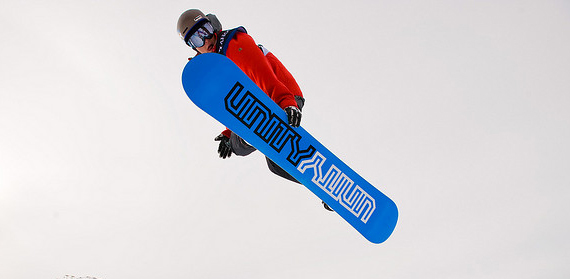Though a slip cost him gold in the half-pipe, and perhaps his title as the king of 21st century snow sports, American snowboarder Shaun White is what a hero looks like in 2014.
White is a phenomenon: a two-time Olympic gold medallist and commercial behemoth. Estimated to be worth approximately US$40m, he earns up to US$7m a year from endorsement deals with companies including Target, Oakley, Hewlett-Packard and Ubisoft.
But White hasn’t been the only one to benefit. Just as importantly, the snowboarder known as The Flying Tomato is the standard bearer of a group of sportspeople who saved the Winter Olympics
Anyone for curling?
Rewind to 1988 and the Winter Olympics was decidedly unfashionable. There the star was Eddie “The Eagle” Edwards – the have-a-go-hero who charmed the world with his foray into ski-jumping. Only the Jamaican bobsled team brought any cool to Calgary. The games consisted of a small number of often minority sports, and existed in the commercial shadow of rival sporting mega-events.
And then along came Douglas Coupland and Richard Linklater: unexpected and unintended godfathers of modern snow sports. Copeland was the author of Generation X: Tales for an Accelerated Culture while Linklater directed the film Slacker, both of which appeared in the early 1990s.
Each helped define a new age – Gen X – populated by people born between the 1960s and the 1980s. Professor Christine Henseler, author of a book on Generation X, characterises it as:
… a generation whose worldview is based on change, on the need to combat corruption, dictatorships, abuse, AIDS, a generation in search of human dignity and individual freedom, the need for stability, love, tolerance, and human rights for all.
In the mid-90s, US sport broadcaster ESPN identified this new social grouping as a potential market and created annual events known as the X-Games. The games consisted of newer sports with a more “extreme” focus such as snowboarding, skateboarding or freestyle motocross.
Just as in the Olympics, the X-Games featured summer and winter versions and participants could win gold, silver and bronze medals. By the early part of last decade the winter version was well established as a serious rival, and could boast of more US viewers than the Winter Olympics.
The International Olympic Committee (IOC) responded to the emergence of Gen-Xers and their new rival event by adding newer, hipper sports like snowboarding or slopestyle skiing to the roster of Winter Olympics competitions. Indeed, The Economist recently identified at least 20 of the 98 official events in Sochi as “cool”.
Generation post-Olympics?
While some observers think the likes of White have now gone mainstream, others have speculated about the potentially more fundamental implications of slacker-induced generational change.
In a blog for the Harvard Business Review during the Sochi Games, Scott Anthony pondered whether the X-Games could be a case of disruptive innovation, having the same effect on the Olympics as digital cameras had on Kodak or Netflix had on Blockbuster.
The X-Games has indeed found a foothold among customers that are not served well by existing sports, and it has a broader market appeal than its rivals. This raises the possibility that we are on the cusp of disruptive change in the worlds of Olympic and winter sports.
However, Anthony discounts this possibility. The third factor common to such disruptive change is a sense of malaise on behalf of the incumbent. Effectively, Kodak and Blockbuster failed to respond to an new rival and therefore ultimately perished.
But a sense of “cool” has already infused the Sochi Games, with long hair, tattoos and baggy clothes common in the newer events. The IOC is clearly responding, and the Winter Games is unlikely to succumb to its upstart rival.
Get engaged
Shaun White, half-pipes and the writing of Douglas Coupland nevertheless do have some important lessons for sport. Global mega-trends have always been at the root of developments in sport; look no further than football, the product of socio-economic change and the need for leisure activity. The so-called “cool” sports scheduled into the Olympics therefore reflect the IOC’s adaptation to broader global changes rather than an admission of defeat.

Marketers now consider “engagement” the key to commercial success. That is, getting people interested in the product before the hard sell. The engagement offered by Gen-X sports is incredible – think how often you see snowboarders or base jumpers used to sell everything from insurance to energy drinks. Getting them on board represents good business for the IOC.
There is also the need to keep sport “products” (events, competitions, contests) fresh and relevant. F1 Grand Prix racing is grappling with similar issues at the moment and has changed its racing rules to reflect issues such as the intensity of competition, safety and environmental concerns.
Including sports like snowboarding in the Olympics is from the same school of “product management” – ensuring that new features are regularly added to an event to stimulate consumer interest and build a sustainable fan-base.
Snowboarding may not therefore be the arch-nemesis of traditional winter sports, inducing disruptive and irreversible change. Rather, it represents an adaptation to global trends that ensures the continued relevance and accessibility of Winter Olympics.
Simon Chadwick does not work for, consult to, own shares in or receive funding from any company or organisation that would benefit from this article, and has no relevant affiliations.
This article was originally published on The Conversation.
Read the original article.




Comments are disabled